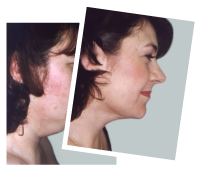Benign lesions, or non-cancerous skin lesions, like moles and skin tags are extremely common. These include moles, skin tags, freckles, and seborrheic keratoses. No matter how aesthetically displeasing they may be, nearly everyone has an existing mole or two.
But as people become more conscious of their look and how to achieve a particular aesthetic, and with the increasing publicity about the sun and its potential to cause skin cancer, people have started to look at their normal skin growths with new concern.
But which skin growths should we be concerned about? How do we develop moles? What are the treatments? Can they cause skin cancers? How concerned should I be?
With so many questions about the topic, at Me Clinic, we wanted to help provide a detailed guide that can help and inform you on this content, and help answer the variety of questions that you might have.
What are moles?
Similarly to tumours, moles are made up of an overgrowth of cells. However, unlike tumours, moles are nearly always benign (non-cancerous).
Perhaps because moles are mostly benign, they have not been extensively studied. Moles are commonly associated with genetic inheritance, but even this pattern of genetic inheritance is yet to be fully understood.
Moles typically have dark brown centres, but can also occur as red, pink, black, and flesh-coloured. Additionally, some moles have hairs growing on them, whereas others don’t. Moles come in all shapes and sizes. So how can we tell the difference between them?
Types of moles
Congenital Nevi – These are the moles you are born with or appear throughout your early years. Around 1-2% of newborns will have congenital nevi. These moles are more likely to develop into melanoma than the moles which appear after birth. Your family doctor will often keep an eye on this and refer to an appropriate specialist if deemed necessary.
Dysplastic Nevi – Otherwise known as atypical moles, these moles are often larger and more irregularly shaped. They can be light or dark, and be raised with uneven edges. These moles are often hereditary and are at a greater risk of developing into melanoma. Any changes observed in dysplastic nevi moles should be checked by a dermatologist or skin doctor.
Common or Acquired Nevi – These are common moles that are typically acquired through life. They can be pink, red, or brown. They often appear as a result of sun damage.
How are moles caused?
As stated above, moles are caused due to an abnormal growth of cells. Although this abnormal growth resembles that of the formation of a tumour, not all moles are cancerous. Moles are extremely common. In fact, the Australasian College of Dermatologists has suggested that Australian children by the age of 15 have over 50 moles on average.
You can either be born with moles, as in the case of congenital nevi, or new moles occur as you age. Sun exposure without the appropriate protection can also result in the formation of moles. Any new moles that appear should be checked by an expert.
Which moles are cancerous?
The moles that should be of any medical concern are usually the ones that look different than any of the others on your body. These moles are often raised, have a rugged edge, and typically change in size.
New moles and the surrounding skin should be checked by a dermatologist. Existing moles that have changed in size, shape, colour, or become painful and start to bleed should also be checked, especially if there is a concern around skin cancer. You can examine yourself using a mirror, or find somebody you are comfortable with to check your moles. Pay extra attention to areas that are often exposed to the sun for prolonged periods of time such as the backs of your arm, the back of your neck, and your back. Also check at areas you normally don’t look at e.g hands, toes, scalp, genital and anal areas.
The first five letters of the alphabet can be used as a guide to help you identify any of the warning signs of melanoma.
A – Asymmetry – Melanomas are rarely symmetrical. Instead, they look like they are composed of two halves of differing shapes and sizes. You can try drawing a line down the middle of the mole to check for symmetry.
B – Border – Normal moles tend to have an even, smooth border. Melanoma borders tend to be rugged and uneven and may possess notched edges.
C – Colour – Normal moles should be of a uniform colour. If a mole is composed of various shades of brown, black, or pink, this could be a warning sign for melanoma.
D – Diameter – As with all possible cancers, it is best to detect a melanoma when it is small. If the mole is larger than a pencil eraser – larger than 6mm in diameter- then this warrants a check by a doctor.
E – Evolving or Enlargement – A mole that evolves its shape, size, colour, or elevation OR displays new symptoms associated with pain and bleeding could be a sign of melanoma.
Melanomas can appear anywhere on the body, including underneath your nail, the sole of your foot, and in your genital region. Keep an eye out for all unusual growths and get them checked out.
Another warning sign or criteria some people like to refer to is called the “Ugly Duckling”. This recognition strategy is based on the idea that most moles on your body are identical, whereas a melanoma will stand out. What does this mean? Well, it encourages you to not only look for the ABCDE criteria but to compare moles with one another.
Lastly, moles that lack melanin – the brown pigment – are known as amelanotic melanomas. These moles will appear lighter in colour, either pink, red, or white, making them difficult to recognise.
What are skin tags?
Unlike moles, skin tags – or acrochordons – are small, soft, painless growths on the skin that are non-cancerous. They’re common and harmless and can usually be removed. Skin tags can appear anywhere on the body, although they most commonly present in areas where your skin folds or rubs, such as:
- Groin
- Armpits
- Thighs
- Eyelids
- Neck
- Around your breasts
Skin tags have a warty appearance, but their characteristics differ. Skin tags are usually:
- Smooth (warts are often rough and irregular in shape)
- Knobbly and “hang” (warts are only slightly raised or flat)
- Not contagious (skin tags are not a sign of infection, whereas warts can be spread through skin-to-skin contact)
Causes of skin tags
Although the main mechanism of the formation of skin tags is still relatively unknown, what we do understand is that skin tags are made up of loose collagen fibres and blood vessels enclosed by a layer of skin.
Both men and women can develop skin tags, and they most commonly occur in the elderly (due to excess skin as a result of ageing), those who are overweight, and those who perform contact sports.
Some people may inherit the susceptibility of acquiring skin tags through genetics. Studies have also shown that pregnant women have an increased chance of developing skin tags due to hormonal changes.
Although skin tags are more commonly present in older teens and adults, the presence of skin tags in children has reportedly increased throughout the years. This is thought to be associated with the global rise of childhood obesity.
Treatments
Skin tags are painless and harmless. In most cases, getting skin tags removed is purely for aesthetic or cosmetic reasons. If skin tags are affecting your confidence or self-esteem, or they are inconveniently snagging on jewellery or clothes, we recommend you contact Me Clinic for an evaluation and treatment plan, and discuss having your skin tags treated or removed.
Skin tags may sometimes fall off on their own if the tissue gets twisted or lacks a blood supply.
Removing Moles and Skin Tags
Most skin tags and moles do not require treatment. Skin tags especially, are painless and harmless, and so removing skin tags is more for aesthetic purposes.
Moles that look different, are larger, or of a different colour may warrant removal if your doctor fears a sign of melanoma. Additionally, moles that are raised and are in areas of inconvenience such as your scalp (risk of getting cut during a haircut), groin (uncomfortable rubbing of the mole), or protruding on your face can also be removed.
How is a mole or skin tag removed?
There are a variety of medical procedures that our professional team can utilise to remove skin tags and moles, such as:
Shaving or cutting – using state-of-the-art electrosurgery equipment to cut or shave your skin tag or mole down to the skin. This procedure has minimal recovery times and very little bleeding. However, some moles may have cells growing underneath the skin. These will require the entire mole to be removed from a deeper layer of the skin, and may require stitching.
Freezing – Another option for mole or skin tag removal is through the use of liquid nitrogen. A small amount of liquid nitrogen is put onto the skin tag or mole, which causes it to dry up and fall off. This procedure may result in the formation of a small blister where your mole or skin tag was, but is performed with minimal discomfort to the patient and will slowly disappear over time.
Burning – The most painful method of skin tag and mole removals, involves the use of a hot surgical wire to burn the upper layers of the skin. The heat from the wire helps prevent bleeding and promote scabbing, although multiple treatments may be needed for the full desired effect.
Are there any risks to removing moles and skin tags?
The biggest risk with removal is infection. Our team will be making an incision or a cut, which leaves an open area for bacteria to enter. Following postoperative wound care appropriately can help minimize your risk of infection.
Bleeding can sometimes occur, especially if you are taking blood-thinning medications. Hold pressure gently on the area using gauze. If bleeding is continuous then we recommend coming back in for a follow-up.
Moles should not return once excised. If a mole does return, this could indicate a sign of melanoma. Keep watch of the area of your mole and report any regrowths. Skin tags usually won’t return once cut off. They may return if that area continues to rub.
Can you remove moles and skin tags at home?
Whilst innovation and inventiveness has sparked during our shelter throughout the coronavirus pandemic, people have begun tackling DIY projects from building new shelves to DIY surgery and removing moles or skin tags.
Removing a skin tag or mole using home remedies such as nail clippers, scissors, or freezing gels is cautioned by most doctors. These “simple fix” solutions can lead to deep infections, bleeding, and scarring. Even less aggressive treatments like bleaching agents, tea tree oil or apple cider vinegar can still negatively affect the skin.
In all cases, it is best to caution against home treatments, and It is more important for you to get your moles checked out by an expert, so they can provide medical advice before they are removed, in case any additional work-up is required.
Get Your Skin Tags and Moles Treated
At Me Clinic, our highly qualified professional staff are ready to help you achieve the body aesthetic goals that you want. Our philosophy is simple, we want you fully informed, and will provide medical advice to ensure that you are prepared to make the best decision possible for your needs.
If you have more questions, or are interested in surgical removal options for your moles and skin tags, please reach out to us to begin your journey with us today.





